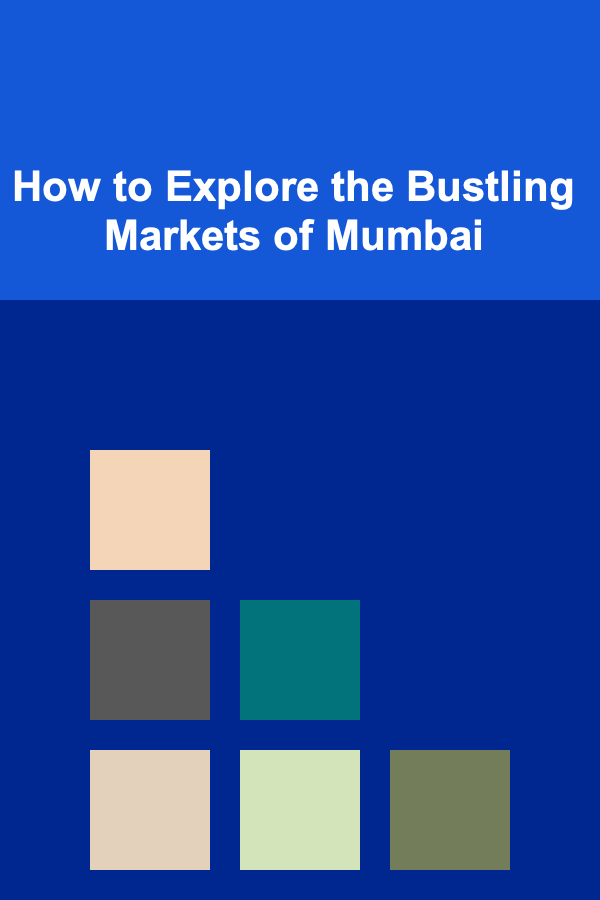
How to Explore the Bustling Markets of Mumbai
ebook include PDF & Audio bundle (Micro Guide)
$12.99$11.99
Limited Time Offer! Order within the next:

Mumbai, often referred to as the "City of Dreams," is a melting pot of diverse cultures, rich history, and vibrant colors. It is a place where old-world charm meets modern hustle, and nowhere is this more evident than in its bustling markets. Whether you're a seasoned traveler or a first-time visitor, exploring the markets of Mumbai offers a fascinating glimpse into the life of this bustling metropolis. In this article, we'll take you on a journey through some of the most iconic markets of Mumbai, providing insights into their history, must-visit stalls, and tips for making the most of your shopping experience.
The Soul of Mumbai: Markets as Cultural Hubs
Markets in Mumbai are not just places to buy and sell; they are cultural hubs that offer a deep dive into the city's diverse heritage. Mumbai's markets have long been a meeting point for people from various walks of life, from street vendors to affluent shoppers. They serve as the pulse of the city, where one can witness the energy of commerce, art, and daily life.
The city is home to an eclectic mix of markets, ranging from traditional bazaars brimming with spices, textiles, and handicrafts, to upscale shopping districts that cater to international brands. These markets often tell the stories of Mumbai's past, reflecting the city's colonial history, Islamic influence, and indigenous traditions. Exploring these markets is not just about shopping, but also about understanding the social fabric that makes Mumbai unique.
The Iconic Crawford Market: A Glimpse of Old Mumbai
History and Significance
Crawford Market, now officially known as Mahatma Jyotiba Phule Market, is one of Mumbai's oldest and most iconic markets. Established in 1869, this market stands as a testament to the city's colonial past. Designed by the British architect William Emerson, the market's architecture reflects Victorian influences, and it remains an important symbol of Mumbai's history. The market was originally built to house wholesale goods, with a focus on imported and domestic products, and over the years, it has evolved into a multi-purpose market catering to a wide variety of goods.
What to Explore
Crawford Market is renowned for its colorful displays of fruits, vegetables, meats, and dry goods. The market is divided into different sections, each specializing in a particular category of products. The fruit and vegetable section is a riot of colors, with fresh produce stacked high in vibrant displays. The meat section, though less visited by tourists, is an authentic representation of Mumbai's food culture, offering everything from fresh seafood to exotic meats.
Beyond the food, Crawford Market also offers a range of other items, including pet animals, household goods, and traditional Indian spices. The market is a sensory overload, with the aromas of spices, the noise of bargaining, and the sights of colorful fabrics and trinkets filling the air.
Tips for Visiting Crawford Market
- Visit Early in the Morning: To avoid the crowds, visit Crawford Market early in the morning when the market is just waking up. This is also the best time to experience the market in its most authentic form, as vendors are busy setting up their stalls and goods are freshly delivered.
- Bargaining is Key: Like most markets in Mumbai, bargaining is common in Crawford Market. Don't be afraid to haggle with vendors to get the best prices, but always do so respectfully.
- Stay Aware of Your Belongings: As Crawford Market can get quite crowded, it's important to stay vigilant about your belongings. Keep your wallet and valuables secure.
Colaba Causeway: The Shopper's Paradise
History and Atmosphere
Colaba Causeway is a bustling street market located in South Mumbai. It is one of the most popular shopping streets in the city, attracting both locals and tourists. The market stretches from the Colaba Causeway to the Gateway of India, offering a vibrant blend of street stalls, boutiques, and high-end stores. The market is a reflection of Mumbai's dynamic energy, with its mix of old and new, traditional and modern.
What to Explore
Colaba Causeway is known for its eclectic mix of products, ranging from clothing and accessories to antiques, jewelry, and souvenirs. You can find everything here, from traditional Indian fabrics like sarees and dupattas to trendy Western clothing. Street vendors line the road selling jewelry, bags, and handicrafts, making it the perfect spot to pick up unique souvenirs.
One of the standout features of Colaba Causeway is the presence of several independent boutiques and designer stores. If you're looking for more high-end shopping, this is the place to find both international and Indian designers offering the latest fashion trends. The area also offers a variety of food stalls serving local snacks like vada pav and pav bhaji, perfect for refueling after a long shopping spree.
Tips for Visiting Colaba Causeway
- Prepare for Crowds: Colaba Causeway is often crowded, especially on weekends. If you want to avoid the hustle and bustle, try to visit on a weekday.
- Don't Miss the Gateway of India: While exploring Colaba Causeway, be sure to stop by the iconic Gateway of India, just a short walk from the market. It's a great spot for photos and a moment of reflection on Mumbai's history.
- Set a Budget: Given the range of items available, it's easy to get carried away while shopping in Colaba Causeway. Set a budget beforehand to avoid overspending.
Zaveri Bazaar: The Heart of Jewelry Shopping
History and Legacy
Zaveri Bazaar is Mumbai's most famous jewelry market, and it's located in the heart of the city. Established over 150 years ago, Zaveri Bazaar is the hub of gold, silver, and diamond jewelry trading in Mumbai. It is home to over 1,000 jewelers, making it one of the largest jewelry markets in India. The bazaar is a historical and cultural landmark for the city, offering a glimpse into the opulence and craftsmanship of Indian jewelry.
What to Explore
If you're in the market for exquisite jewelry, Zaveri Bazaar is the place to be. From traditional gold jewelry, including intricate wedding sets and temple jewelry, to modern diamond pieces, this market has something for everyone. The narrow, bustling lanes are filled with glittering showrooms that display an array of beautiful pieces. Whether you're looking for a timeless piece to take home or simply want to window shop, Zaveri Bazaar offers a unique experience.
Apart from jewelry, you can also find a variety of other products such as antiques, religious items, and textiles. Many shops also offer custom-made pieces, so if you have something specific in mind, don't hesitate to inquire.
Tips for Visiting Zaveri Bazaar
- Negotiate with Care: Jewelry is often priced based on weight and quality, but you can still negotiate. It's advisable to know the current gold and diamond rates before entering a shop.
- Check for Purity: Ensure the jewelry you purchase is certified for purity. Many stores offer certifications for gold, diamonds, and other precious stones, so ask for them.
- Visit During Weekdays: Zaveri Bazaar can get extremely crowded, especially during festival seasons like Diwali. To avoid the rush, visit on weekdays, when the market is quieter.
Dharavi Market: The Hidden Gem of Mumbai
History and Significance
Dharavi, known as one of the largest slums in Asia, is often overlooked by tourists. However, it is home to a thriving market that is a testament to the resilience and entrepreneurial spirit of Mumbai's underprivileged communities. Dharavi Market is known for its industrial and craft production, from pottery to leather goods and textiles.
What to Explore
Unlike the commercial markets of South Mumbai, Dharavi offers a more authentic and off-the-beaten-path shopping experience. The market is a maze of narrow lanes and alleyways where small-scale industries and artisans create and sell a variety of goods. You can find handmade leather products, including bags, shoes, and wallets, as well as colorful textiles and pottery. The market is also home to a variety of street food vendors selling delicious local snacks.
Dharavi Market is not just about shopping; it's about understanding the community's resourcefulness and creativity. Visiting this market offers a deeper insight into Mumbai's socio-economic divide and the ingenuity of its people.
Tips for Visiting Dharavi Market
- Take a Guided Tour: While Dharavi is not a typical tourist destination, guided tours are available that offer a safe and informative way to explore the market. A local guide will provide insights into the history, culture, and industries of Dharavi.
- Be Respectful: Dharavi is home to a large population living in challenging conditions. When visiting, be mindful of the local residents and their way of life. Always ask for permission before taking photos.
- Support Local Craftsmen: Purchasing goods directly from the artisans is a great way to support the local community. By doing so, you're helping to sustain their livelihoods and promoting ethical trade.
Tips for Exploring Mumbai's Markets
- Plan Your Route: Mumbai's markets can be spread out across the city, so plan your route carefully to make the most of your time. If you're visiting multiple markets, consider hiring a taxi or using ride-sharing services to get from one place to another.
- Dress Comfortably: Mumbai's markets can get hot and crowded, so it's important to dress comfortably and wear comfortable shoes for walking.
- Stay Hydrated: The city's tropical climate can be intense, especially in the summer. Carry a water bottle and stay hydrated while exploring the markets.
- Keep Cash on Hand: Many vendors in Mumbai's markets don't accept credit cards, so it's a good idea to carry cash with you. ATMs are available, but it's always better to be prepared in advance.
Conclusion
Mumbai's markets are an essential part of the city's identity. They offer a microcosm of the city's diverse culture, history, and economy. From the grandeur of Zaveri Bazaar to the vibrant streets of Colaba Causeway and the bustling lanes of Dharavi, Mumbai's markets provide a unique experience for every traveler. Whether you're looking to shop for souvenirs, discover local crafts, or immerse yourself in the energy of the city, the markets of Mumbai offer a dynamic and unforgettable experience.
Exploring these markets is a journey through time, culture, and commerce, and there's no better way to experience the soul of Mumbai than by wandering through its bustling bazaars.

How to Care for Your Home's Air Conditioning System
Read More
How to Decorate Your Home with Budget-Friendly Plants
Read More
How to Plan Fun and Engaging Activities for Seniors
Read More
How To Learn Object-Oriented Programming (OOP) Principles
Read More
Interpreting Flood Myths: A Global Perspective
Read More
How to Plan Baby's First Year Health & Wellness
Read MoreOther Products

How to Care for Your Home's Air Conditioning System
Read More
How to Decorate Your Home with Budget-Friendly Plants
Read More
How to Plan Fun and Engaging Activities for Seniors
Read More
How To Learn Object-Oriented Programming (OOP) Principles
Read More
Interpreting Flood Myths: A Global Perspective
Read More